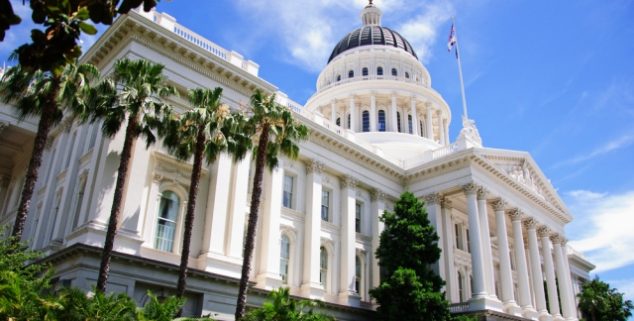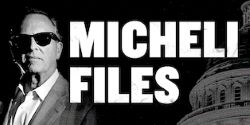Micheli Files
An orientation to the California Capitol for lobby day attendees
 The state Capitol in Sacramento. Photo: Feoktistoff, via Shutterstock)
The state Capitol in Sacramento. Photo: Feoktistoff, via Shutterstock)This edition of the Micheli Files is intended to provide an orientation to the California State Capitol and its accompanying Swing Space for individuals participating in a lobby day. Part II of last week’s Micheli Files, More insights on drafting legislation in California, will run next week.
The State Capitol
The California State Capitol is the seat of state government, located in Sacramento. The building houses the chambers of the State Legislature, which is comprised of the Assembly and the Senate. We often refer to this building as the historic side of the Capitol.
The first floor holds the original offices of California’s Governor (actually a 3-room suite), two offices of the Treasurer, Attorney General, and Secretary of State. There is also a State Library exhibit room and a State Archives exhibit room.
The Senate has two hearing rooms on the first floor – 112 and 113. There is a small meeting room as well.
 The Assembly has two hearing rooms on the first floor – 126 and 127. There is also a small meeting room in 125. The Assembly also has three hearing rooms on the fourth floor – 437, 442, and 447.
The Assembly has two hearing rooms on the first floor – 126 and 127. There is also a small meeting room in 125. The Assembly also has three hearing rooms on the fourth floor – 437, 442, and 447.
On the second floor are the ornate offices of the Assembly Speaker and Senate President pro Tempore, as well as the Willie L. Brown, Jr. Conference Room on the Assembly side and two small meeting rooms on the Senate side.
Of course, the Chambers of the Assembly and Senate and the formal entrances to them are located on the second floor. Try not to miss seeing the grand staircases which you walk (or take the elevators to the second and third floors). In the Chambers, they are designed to look as they did more than 125 years ago, including original desks from 1869.
On the third floor of the Capitol are the galleries of the Assembly and Senate. The Assembly is located on the north side of the Capitol, which is the L Street side, while the Senate is located on the south side of the Capitol, which is the N Street side. The offices on this floor currently house the offices of the Assembly Chief Clerk and the Senate Secretary.
The California State Capitol serves as both a museum and the state’s working seat of government.
A few facts about the Capitol building:
The Dome is 8,909,200 pounds of cast-iron with 108 windows and was constructed between 1855 and 1866.
The statue at the top of the dome is the Statue of Freedom.
The Rotunda stands 180 feet, three inches in height and is 96 feet in diameter.
Construction on this permanent Capitol was begun in 1860, and, though not completed until 1874, the Legislature was able to occupy its two Chambers in 1869. So, our state Capitol has been the seat of state government for over 150 years.
Admission to the Capitol is free of charge (you just have to enter on either the L Street or N Street sides and go through security like at the airport). It is open to the public! Be sure to stop by Capitol Books & Gifts. It is located inside the Capitol on the lower level, often referred to as the Capitol basement, which also has the Legislative Bill Room, the guided tours office, a cafeteria, and eating and meeting space (which is called the Eureka Room). Photography at the State Capitol Museum is welcome, but flash is not allowed.
California’s first state capital was San Jose, which served in this role from 1849 to 1851. The state’s first legislature convened there following the adoption of the 1849 constitution, which was our first one, prior to California’s admission to the union in 1850.
After San Jose, the capital moved to several other cities before settling in Sacramento, including Vallejo, Benicia, and temporarily to San Francisco during a flood.
According to Alex Vassar, a State Historian and key staff member at the California State Library, on the second floor of the Rotunda, there is a large tile mosaic on the floor. One piece was intentionally placed backwards as a reminder that nothing perfect exists on earth.
The California Capitol is built in the Neoclassical style and was completed between 1861 and 1874. Located at the west end of Capitol Park and the east end of the Capitol Mall, the building was added to the National Register of Historic Places in 1973.
The California Senate chamber seats its forty members in a large chamber decorated in red, which is a reference to the British House of Lords (also the upper house of a bicameral legislature). The chamber is entered through a second-floor door. From the ceiling hangs an electric reproduction of the original gas chandelier. A hand-carved dais caps off a recessed bay framed by Corinthian columns.
The Latin phrase “Senatoris est civitatis libertatem tueri” (“It is the duty of the Senator to guard the civil liberties of the Commonwealth”) lines the cornice. A portrait of George Washington is on the wall above. The State Seal hangs above.
The California Assembly chamber is located at the opposite end of the building. Its green colors are based on those of the British House of Commons, the lower house. The dais rests along a wall shaped like an “E”, with the central area housing the rostrum. Along the cornice is the Assembly motto, in Latin: Legislatorum est justas leges condere (“It is the duty of legislators to establish just laws”)
The Capitol Annex, which previously housed all legislator offices, five hearings rooms, the Governor, Lt. Governor, and DOF, was vacated in 2021 in preparation for its demolition and replacement with a new Annex on the same site. Demolition was delayed until 2023 by lawsuits about the project’s environmental impacts to the trees in Capitol Park, which is immediately adjacent to the Annex site. The offices and personnel previously in the Annex moved into the newly constructed Capitol Annex Swing Space building until the new Annex is constructed, which is expected to be completed by Fall 2027.
The Swing Space
The so-called “swing space” is the temporary home for legislators, the Governor, Lt. Governor, and other key legislative branch personnel while the new Annex is being built that adjoins the historical State Capitol. It is located at 1021 O Street, across from the Secretary of State and the California Museum.
In the swing space, the Assembly has one hearing room, 1100, on the first floor, located on the west side of the building. The Senate has three hearings rooms, 1200 on the first floor, on the east side, along with 2100 and 2200 on the second floor. There is also a formal press conference room near room 2100.
On the third floor, you will find a small cafeteria, but it does not have seating. There are also offices for half a dozen Senate committees, the Director of the Department of Finance, the Legislative Counsel, the Senate and Assembly Sergeants at Arms, CHP, DGS, and others.
On floors 4 through 8, you will find the offices of legislators, with most leadership members on the 8th floor. The 4th and 5th Floors have only Assembly offices, while the 7th floor only has Senate Offices. On the 6th Floor and 8th Floors, they are split with Senate offices on the east side and Assembly offices on the west side. Note that there are a handful of committee offices scattered on the 8th, 7th, and 6th floors as well.
Note that the Assembly Health Committee chair’s office is housed with the Assembly Health Committee staff in their office located on the third floor of the Legislative Office Building (always called the LOB), which is located at 1020 N Street.
Finally, the Governor’s Office is housed on the 9th and 10th floors of the Swing Space, while the Lt. Governor’s Office is located in the Swing Space on the 8th floor.
Support for The Micheli Files is provided by The McGeorge School of Law Capital Center for Law & Policy
Want to see more stories like this? Sign up for The Roundup, the free daily newsletter about California politics from the editors of Capitol Weekly. Stay up to date on the news you need to know.
Sign up below, then look for a confirmation email in your inbox.

Leave a Reply